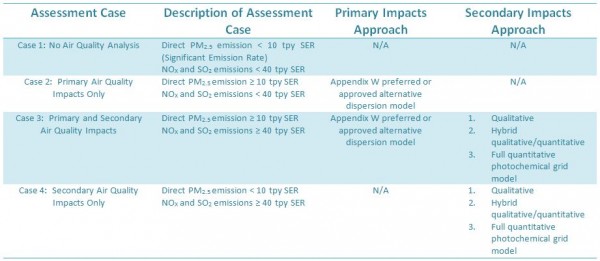PM2.5 Modeling Guidance Released by U.S. EPA
Posted: March 14th, 2013
Author: All4 Staff
On March 4, 2013 the U.S. EPA Office of Air Quality Planning and Standards (OAQPS) released “Draft Guidance for PM2.5 Permit Modeling” memorandum. The memorandum provides additional clarification on addressing both primary and secondary formed fine particulate (PM2.5) in National Ambient Air Quality Standards (NAAQS) and Prevention of Significant Deterioration (PSD) Increment air quality modeling demonstrations. The OAQPS Air Quality Modeling Group also conducted a webinar on March 13, 2013 providing an overview of the draft memorandum. The slides from this presentation can be found here.
On January 4, 2012, the U.S. EPA granted a petition previously submitted by the Sierra Club on July 29, 2010, to initiate rulemaking which designates air quality models for ozone and PM2.5 for use by all major sources applying for a PSD permit. The U.S. EPA committed to engage in rulemaking to evaluate updates to Appendix W of 40 CFR Part 51 “Guideline on Air Quality Models” which would incorporate new analytical techniques or models for ozone and secondary PM2.5. The release of this guidance document meets U.S. EPA’s commitment to the Sierra Club petition. U.S. EPA will accept comments on the memorandum until April 17, 2013. Additional comments will be taken into consideration during the Air and Waste Management Association’s (AWMA) Specialty Modeling Conference scheduled for March 19-21, 2013 and during the 2013 Regional, State, and Local (RSL) Modelers’ Workshop currently scheduled for April 22-25, 2013. On April 23rd, the RSL Workshop will be open to industrial representatives and consultants. OAQPS then intends to finalize the guidance memorandum by July 31, 2013.
The draft guidance memorandum outlines four (4) separate procedures for addressing primary and secondary formed PM2.5 based on the following assessment cases:
Assessing primary formed PM2.5 will not differ any from how historical air quality modeling demonstrations have been completed for other pollutants. U.S. EPA’s approved air dispersion model AERMOD will still be used to assess primary PM2.5 impacts for comparison to the 24-hour and annual NAAQS and PSD Increments. To address secondary formed PM2.5 from nitrogen oxides (NOX) and sulfur dioxides (SO2), the draft memorandum outlines three (3) separate procedures for Cases 3 and 4 including:
- A qualitative assessment,
- A hybrid of qualitative and quantitative assessments utilizing existing technical work,
- A full quantitative photochemical grid modeling exercise.
U.S. EPA indicates that in most situations a qualitative assessment of the impacts from secondary PM2.5 formation will suffice for demonstrating that secondary PM2.5 impacts associated with a source’s precursor emissions will not cause or contribute to a violation of the 24-hour or annual PM2.5 NAAQS. Each qualitative demonstration will be unique; however, the memorandum outlines the following factors that should be thoroughly justified.
- A detailed conceptual description of the background air pollution concentrations,
- A narrative explaining how any identified significant precursor emissions and subsequent secondary PM2.5 formation could contribute to the existing PM2.5 concentrations in the region,
- A conceptual description of the meteorological conditions in the area that occur during high periods of 24-hour PM2.5 concentrations and how meteorological factors could enhance or limit the formation of secondary PM2.5 from any significant precursor emissions.
The second approach to demonstrating compliance with PM2.5 precursors is the hybrid qualitative/quantitative approach. In addition to the steps involved in a qualitative assessment outlined above, a quantitative analysis would involve reviewing past or current State Implementation Plan (SIP) attainment demonstration modeling, published modeling studies, or peer-reviewed literature with estimates of model responsiveness to precursor emissions. Another potential quantitative assessment outlined in the memorandum, for use in the hybrid approach, would involve converting emissions of precursors into equivalent amounts of direct PM2.5 emissions. Pollutant offset ratios and dispersion modeling would be used to assess the impacts of the combination of direct PM2.5 emissions and equivalent direct PM2.5 emissions.
The last and most involved method to demonstrate compliance with PM2.5 precursors would be the use of a photochemical grid model to do a full quantitative assessment. U.S. EPA indicated that the need for a full quantitative assessment with a photochemical grid model would only happen in rare cases. However, if a full quantitative assessment was required, the memorandum states that an alternative model as outlined in Section 3.2.2 of 40 CFR 51.112 and 40 CFR Part 51 Appendix W should be used. The memorandum recommended the use of a Lagrangian or Eulerian photochemical grid model for the full quantitative assessment but did not identify a specific model.
Even though the guidance is still draft and out for review it seems as though States are moving forward with requiring an assessment of PM2.5 precursors for facilities that trip Significant Emission Rates (SER) for NOX or SO2. Facilities should keep in mind that there is the possibility of a substantial amount of effort involved assessing PM2.5 precursors. Especially, as the first facilities go through the process. This guidance memorandum along with the recent court decision on the PM2.5 Significant Impact Level (SIL) is making it more important for facilities to look for emission reductions or controls to try and remain below PM2.5 and precursor (i.e., NOX and SO2) SER. In addition, this is one of the first times OAQPS has provided a public review process for a guidance memorandum. Therefore, make sure your voice is heard before April 17th so that your comments can be taken into consideration.

